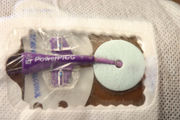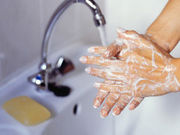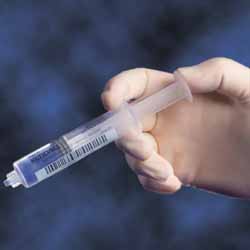Taking Care of your Peripherally Inserted Central Catheter (PICC)
Contents
- 1 Goal
- 2 Introduction
- 3 How Does the PICC Line Get Inserted?
- 4 How Does the PICC Line Stay In Place?
- 5 What Kind of Complications Can Occur?
- 6 HandwashingFlushing the Catheter: For Outpatients Only
- 7 Bathing With Your Catheter
- 8 Necessary Lifestyle Adjustments With Your Catheter
- 9 What Type of Catheter Do I Have?
- 10 Questions?
- 11 Activity
- 12 Multichoice Quiz
Goal
This online module is designed so that you, the patient, will understand what a PICC line is, how it works, and how to care for one safely.
At the completion of this module you, the patient, will be able to:
|
Introduction
Your doctor has recommended that you have a Peripherally Inserted Central Catheter (PICC) placed. A PICC line is a flexible silicone or polyurethane catheter (tiny tube) that is ordered when a patient will need IV medications for several days to months. A PICC line may be used for the administration of blood, electrolytes, IV fluids, chemotherapy, antibiotics, or other intravenous therapies.
There are many types of intravenous catheters. A specially trained Registered Nurse has examined your veins, and with your doctor determined the type of catheter that needs to be inserted for your needs.
PICC lines come in different sizes and styles. They can be placed in different veins. Most often the catheter is placed in your arm above where it bends at the elbow. PICC lines are threaded through the vein in your arm up to the large vein in your chest. This vein is called the Superior Vena Cava (SVC) and it connects to your heart. It is important that the catheter tip ends in or near this vein. That is because this vein is large and can withstand the irritation that many medications may cause.
PICC certified RN's who have successfully completed extensive training will be inserting and maintaining your PICC line.
How Does the PICC Line Get Inserted?
Once your doctor or nurse has recommended a PICC line catheter for your medications, you will be asked to sign a consent form, authorizing your nurse to place the PICC line. This is required because the PICC line is being inserted in to your body, and stays in for the length of treatment.
The RN will determine the best vein in which to insert the PICC line. This is done by examining your arms, measuring the distance from the insertion site to the end point, and then determining the number of lumens required for your therapy.
The RN will use ultrasound equipment to find your vein and other equipment to assist with proper placement. A local anesthetic, such as lidocaine, is used at the insertion site to make the proceedure more comfortable.
After the PICC line is placed, you will get a chest X-ray, to assure the PICC line is in the correct spot in your body. Sometimes it is necessary to reposition the PICC line and repeat the chest X-ray to ensure proper placement.
How Does the PICC Line Stay In Place?
After the PICC line is placed in your body, the nurse will secure the PICC line with a device that keeps your catheter from moving around. This device is a special piece of adhesive which is a part of the sterile dressing that will cover your PICC line. Your dressing should be changed every seven days. It will need to be changed more frequently if it becomes wet, soiled or loose. If you are going home with your PICC line, you will be given an appointment to be seen in the Outpatient Infusion Center for dressing changes, or the Home Health agency following your care will arrange for home dressing changes. The photo shows this securement device, under the sterile dressing.
What Kind of Complications Can Occur?
PICC lines are a very safe form of IV through which you can receive fluid and medications. Any time a foreign body is inserted into your body and the skin surface is broken, complications can occur. These complications can include:
- Swelling of the arm
- Signs of infection (soreness, redness, pain, fever, drainage or odor)
- Leaking around the catheter site or the catheter itself
- The catheter will not work properly or will not flush
- Excess catheter is outside the body (the catheter has moved, or migrated)
- Signs of irritation where the catheter exits the arm (redness, soreness, pain, feeling of hardness as you press on the skin directly above the exit site)
- Injection cap becomes disconnected or contaminated
If any of these occur and you are hospitalized, your nurse will notify the Vascular Access Team (PICC RN).
If these problems occur at home, you would contact the Outpatient Infusion Center, or the Home Health agency following your care. If you experience an emergency and are having severe pain or swelling from the catheter site, notify your physician, the agency following you, and go to the Emergency Department immediately.
If the catheter tears or breaks, fold the remaining end of the catheter in half, cover with gauze and secure tightly with a rubber band. Go immediately to the Emergency Department.
Flushing the Catheter: For Outpatients Only
Your nurse will teach you the proper method for flushing your PICC line.
When to flush:
Flushing must be done before and after administering your medications to assure normal functioning of the catheter and prevent clotting problems.
Flush volume:
PICC catheters are flushed with 10 milliliters (ml) of normal saline (NS) unless they are being used for blood draws, blood transfusions, or Total Parenteral Nutrition (TPN). In those circumstances, flush volume is 20 ml of normal saline. A 10 ml size syringe must be used to flush the catheter. A smaller size syringe causes higher pressure which could rupture the catheter.
Flush method:
- Wash hands thoroughly with soap and water.
- You will be provided with pre-filled syringes of normal saline. Tap the side of the syringe to force any air bubbles there may be in the syringe to the top, and gently push the air out.
- Scrub the the end of the catheter (the hub) vigorously with an alcohol wipe for 5-10 seconds. Use an action similar to that used when juicing an orange. Scrub both the tip and the threads of the cap.
- If your catheter is the type that has a clamp: a) Unclamp the catheter. b) Attach the syringe onto the injection cap until secure, using a clockwise twisting fashion. c) Inject the saline using the push/pause method (which the nurse will demonstrate). d) Remove the syringe, and then re-clamp the catheter.
- If your catheter does not have a clamp: a) Attach the syringe onto the injection cap until secure, using a clockwise twisting fashion. b) Inject the saline using a push/pause method. c). Remove the syringe.
- Discard syringe in the provided container.
NOTE: If you meet resistance to flushing and you have unclamped the catheter (if you have the type of catheter with clamps) NEVER apply florce to flush your catheter. STOP and contact the Outpatient Infusion Center or agency following your care for further instructions.
Bathing With Your Catheter
We ask that you do not take a shower the day of your catheter is inserted. The following day you may securely wrap the catheter insertion site with plastic wrap. Using tape, seal the plastic wrap above and below the PICC line so it is water tight. Alternatively, your nurse may provide you with a special glove or sleeve to protect your PICC line during showers. Keep the water spray directed away from the catheter arm as much as possible. After showering, remove the plastic wrap.
If your dressing becomes wet, pat dry with a towel and allow to air dry. If the tape or dressing has lifted up, try to secure the edges with tape. If the catheter becomes exposed you will need a dressing change. Call the Outpatient Infusion Center or the Home Health agency following your care, to have your dressing changed. Germs like moist conditions, so it is important to promptly call and arrange an appointment.
Necessary Lifestyle Adjustments With Your Catheter
You have a special catheter that must be carefully protected because the end of the catheter is near your heart. Activities that are prohibited while you have the catheter include:
- Swimming and other water activities
- Lifting heavy weights or objects
- Activities that cause profuse sweating that could loosen your dressing and allow for movement of the catheter.
- Using sharp objects near your PICC line, including scissors.
- Using chemicals that could damage your PICC line, such as nail polish remover or paint thinner.
- Allowing pets to scratch or chew on your PICC line.
Do not hesitate to discuss any lifestyle activity questions you may have with your nurse or physician.
What Type of Catheter Do I Have?
Ask the nurse who inserts your catheter to provide you with this data.
- Catheter Type:
- Catheter Position:
- Internal Length:
- External Length:
- Vein Used:
- Date Placed:
Questions?
Please make a list of questions you still have about your PICC line. Your nurse will be glad to answer any questions.
Activity
Multichoice Quiz



